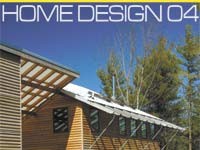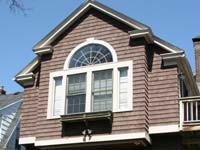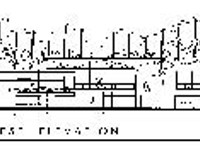Marie Barkley remembers the day a visitor --- a man literally off the street --- walked through her husband Maurice's tree house complex, descended the final ladder, stood on the lawn, and applauded.
Both the Barkleys know the phenomenon well: people driving by their Henrietta home will suddenly slow down, stop, and turn around, usually with at least one child's face pressed up against the back windows. And Maurice Barkley, never one to turn a child away from an opportunity to explore his treetop town, waves them on in.
Barkley built his first tree structure, a platform with a rope bridge, five years ago at the request of his granddaughter. "And I said, 'Hey, this is fun,'" Barkley says. Retired from his career as a commercial artist, he soon gave himself over to a tree house mania. He looked around at all the pine, maple, and locust trees he had planted when he bought the house in 1958, and started to see possibilities. "Luckily," he says, "I overplanted."
Look up in his yard now and you will see eight treetop structures --- including a church, an observatory deck, and several little houses --- six rope bridges, and a spiral staircase. More are on the way. Barkley is working on a structure to look like Buddha. The door will be in his belly.
Barkley makes all the structures in his basement workshop during the winter, takes them out in pieces, and assembles them in the trees in the spring. All the structures are hung with cable from tree limbs and trunks --- nothing is nailed into the trees because the trees continue to grow.
Barkley is a self-taught tree house builder. When he first started, he says, there were only a few books published on the subject, and none were complete. A friend photocopied a couple of pages for him on rope diameters from an engineering textbook. Barkley started with those, and used imagination and experimentation for the rest. There was some trial and error. His first spiral staircase, he says, "was rickety and unsafe and too tight." So he ripped it out and built it again.
Passionate about the safety of his little (and sometimes big) visitors, Barkley makes sure all his structures are overly strong. He uses aircraft cable to hang the houses. Before the tree houses are open to visitors this year he will have restrung all the rope bridges, which can each support 1,000 pounds, he says.
He designs the houses on his computer using a drawing program called FreeHand, and once the designs are perfected, he builds them out of pressure-treated outdoor wood. Once just an avid amateur, Barkley is now armed with a binder full of plans, directions, and photos. He hopes it's enough for a coffee-table book devoted entirely to tree houses.
The tree house town looks like a fairy land. It's decorated with richly colored paint, lattices, morning glory in the summer, dozens of lanterns at night, an enormous, broken clock face ("because time stands still up there," Barkley says), rope swings, and little baskets hooked up to pulleys. "I've been guilty of daydreaming all my life," he says.
Inside the town's two teahouses he's decorated with jeweled mirrors, curtains, and tea sets. His wife Marie, a dressmaker, one day put some old hats, purses, and shawls in the houses. She then watched their two little neighbors dress up and play house. "They went to church, they went shopping, and they went to have tea," she says.
The tree houses are built for children. Adults can safely walk on the platforms, stairs, and bridges, but everything is scaled for children, he says. Railings, for example: Adults can use them but might find them a little low for comfort. For the pull-up basket ("so you can get your juice box," he says), he used "more pulley than you need" just for kids' amusement.
And while his grandchildren, now ages 11 to 17, can still appreciate the houses, Barkley keeps building and tweaking for the smaller kids who visit all through the spring and summer --- school groups, neighbors, friends, strangers who are pulled in from the street.
The Barkleys have guest books full of children's excited comments, mostly thanking them for building such a "cool" "fun" and "really big" tree fort.
But Marie estimates that in another four or five years, when her husband isn't confident that he can keep the tree houses and bridges safe to his standards, they will all come down. He calls his handiwork "ephemeral." But in the meantime, he keeps making improvements to his treetop fairytale --- to the delight of both scheduled visitors and passersby.




